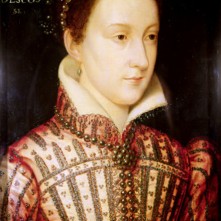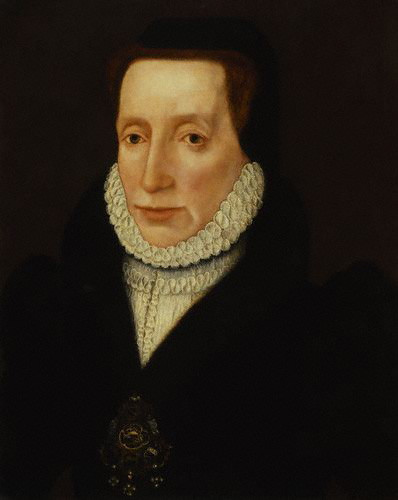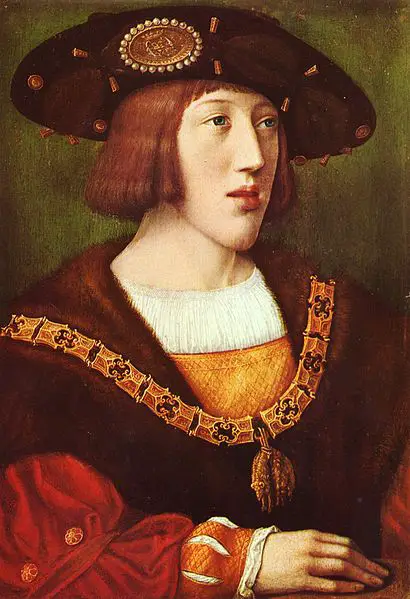11 June
1456 – Birth of Anne Neville, Queen Consort of Richard III, at Warwick Castle. Anne was the daughter of Richard Neville, 16th Earl of Warwick and 6th Earl of Salisbury, known as the Kingmaker, and his wife, Anne Beauchamp.
1488 – Death of James III of Scotland, at Sauchieburn, or “the field of Stirling”. It is not known whether he died in battle or after the battle.
1509 – Marriage of Henry VIII and Catherine of Aragon at Greenwich Palace - click here to read more about it.
1540 – Birth of Barnabe Googe, translator and poet. Googe is known as one of the earliest English pastoral poets.
1544 – Bishops ordered by Henry VIII to ensure that the new litany was “in our native englysshe tonge”.
1560 – Death of Marie de Guise (Mary of Guise), former consort of James V and regent of Scotland, at Edinburgh Castle. Her body lay in a lead coffin at the castle, in St Margaret's Chapel, until March 1561 when it was taken back to France. Marie was buried in the convent of St Pierre at Rheims.
1576 – Death of Sir Anthony Cooke, humanist and educator. Cooke educated his daughters to a high standard, teaching them Latin and Greek, and probably also modern languages and Hebrew. He was appointed royal tutor to Edward VI, but it is not known whether he actually tutored the King. It may have been more of a guiding role. He was buried at Romford, and his effigy can be seen at St Edward's Church there.
12 June
1492 – Burial of Elizabeth Woodville, former consort of Edward IV, next to her husband in St George's Chapel, Windsor Castle.
1511 – Burial of William Courtenay, 1st Earl of Devon, at Blackfriars.
1530 – Catherine of Aragon told Henry VIII to abandon his “wicked” life.
1535 – Richard Rich interviewed Sir Thomas More in the Tower of London. He later reported, at More's trial, that More had denied the royal supremacy during this interview.
1540 - The newly imprisoned Thomas Cromwell wrote to King Henry VIII from the Tower of London, asking for mercy and pleading his innocence.
1553 – Edward VI's council commanded the judges of the King's Bench to turn Edward's "Devise for the succession" into a legal will.
1567 – Death of Richard Rich, 1st Baron Rich and Lord Chancellor, at Rochford. He was buried at Felstead. Richard Rich was Lord Chancellor in Edward VI's reign and went on to serve in Mary I's Privy Council.
1573 – Birth of Robert Radcliffe, 5th Earl of Sussex, courtier and soldier. He was the son of Henry Radcliffe, 4th Earl of Sussex, and his wife, Honor. Radcliffe served Elizabeth I as an ambassador and as Earl Marshal and Colonel General of her army. He was appointed Lord Lieutenant of Essex by James I in 1603.
13 June
1535 – Death of George Neville, 3rd Baron Bergavenny, on 13th or 14th June at his home in Sussex. He was buried at Birling. Neville was a member of Henry VII's council and a Garter knight, but his career was adversely affected when his father-in-law, Edward Stafford, 3rd Duke of Buckingham, fell in 1521. Neville was imprisoned for a year in the Tower of London, and although he was pardoned, he lost his offices and was forced to sell his home, Birling, to the King. He bought back his home in 1530, when he had once again risen in favour.
1574 – Baptism of Richard Barnfield, poet, at the parish church of Norbury, Shropshire. Barnfield published various works in the 1590s, including “The Affectionate Shepheard: Containing ‘The Complaint of Daphnis for the Love of Ganymede’”.
1587 – Death of actor William Knell in a pub brawl in Thame. A coroner's inquest ruled that actor John Towne had drawn his sword and stuck it through Knell's neck in self-defence.
1592 – Death of Henry Scrope, 9th Baron Scrope of Bolton, soldier and warden of the west marches, in Carlisle. He was buried in Carlisle Cathedral.
1595 – Burial of William Wickham, Bishop of Winchester, in Southwark Cathedral.
1596 – Death of Hugh Bellot, Bishop of Bangor and Chester, at Tŷ Bellot, Denbighshire. His funeral was at Chester Cathedral, but he was buried in the parish church at Wrexham.
14 June
1557 – William Peto was made cardinal and papal legate, replacing Reginald Pole, Archbishop of Canterbury, as legate. During Henry VIII's Great Matter, Peto had been Catherine of Aragon's Confessor and had preached in support of her, comparing the King to Ahab.
1571 – Death of Sir Christopher Danby, a Yorkshire nobleman and Catholic. During the Pilgrimage of Grace, he was with the rebels at Pontefract Castle, but escaped punishment. However, his Catholic beliefs did cause him problems in Elizabeth I's reign, and he was brought before the Council of the North for questioning. Again, he escaped being charged.
1572 – Death of Thomas Warton, 2nd Baron Warton, soldier, Justice of the Peace, member of Parliament and a member of Mary I's Privy Council. He died at home, in Cannon Row, Westminster, and was buried in Westminster Abbey.
1598 – Death of Sir Henry Knyvet, MP and soldier, at Charlton in Wiltshire. He was buried in the church at Charlton in July 1598. Knyvet was a Gentleman Pensioner to Elizabeth I, a Justice of the Peace, Sheriff, Deputy Lieutenant, member of Parliament and soldier. He also wrote “Defence of the Realm.”
1612 – Death of Giles Tomson, Bishop of Gloucester, at Windsor Castle. He was buried in Bray Chapel at St George's Chapel, Windsor Castle. He had only been Bishop a year and hadn't even visited his diocese.
15 June

Henry Fitzroy
1519 – Date traditionally given for the birth of Henry Fitzroy, 1st Duke of Richmond and Somerset, at the priory of St Lawrence in Blackmore, Essex. Fitzroy was the illegitimate son of King Henry VIII by his mistress, Elizabeth (Bessie Blount). Henry VIII recognised Fitzroy as his son and gave him a double dukedom in June 1525, making his son the highest ranking peer in the country. Unfortunately, Fitzroy died young in July 1526. Click here to read a bio of Henry Fitzroy.
1536 - Henry VIII sent members of his council, led by Thomas Howard, 3rd Duke of Norfolk, to visit his daughter, the Lady Mary, and bully her into accepting her father as supreme head of the Church in England, and acknowledging that she was not the legitimate heir to the throne.
1547 – Baptism of Peter Bales, calligrapher, schoolmaster and master of micrography, at St Michael Cornhill in London. His micrographical work included a hand-written Bible which could fit into a walnut shell and a ring, which he presented to Elizabeth I, containing a collection of devotional texts. Bales also wrote the copybook “The Writing Schoolemaster”.
1559 – Death of William Somer (Sommers), court fool to Henry VIII, Edward VI and Mary I. Somer had had a narrow escape in July 1535 when Henry VIII threatened to kill him because he praised Catherine of Aragon and Mary, but called Anne Boleyn “ribald” and her daughter, Elizabeth, a “bastard”. Somer's last public appearance seems to have been Elizabeth I's coronation in January 1559. Somer was buried at St Leonard, Shoreditch, London.
1567 – Battle of Carberry Hill, near Edinburgh, between the Protestant nobles and the army of Mary, Queen of Scots and her husband, the Earl of Bothwell. Mary surrendered and was imprisoned. It was the end of her relationship with Bothwell.
1596 – Death of Richard Fletcher, Bishop of London, at his house in Chelsea. He was buried in St Paul's. Fletcher fell out of favour with Elizabeth I and was temporarily suspended of his episcopal duties in 1595 after his marriage, which Elizabeth had warned against.
16 June
 1487 – The Battle of Stoke Field between Henry VII's forces and the Yorkist forces of Lord Lovell and John de la Pole, Earl of Lincoln, who had had pretender Lambert Simnel crowned King Edward VI in Dublin on 24th May 1487. Henry VII was victorious, Lincoln was killed and Lovell fled to Scotland. Simnel was spared by Henry VII, who put him to work in his kitchens. Simnel later became a falconer.
1487 – The Battle of Stoke Field between Henry VII's forces and the Yorkist forces of Lord Lovell and John de la Pole, Earl of Lincoln, who had had pretender Lambert Simnel crowned King Edward VI in Dublin on 24th May 1487. Henry VII was victorious, Lincoln was killed and Lovell fled to Scotland. Simnel was spared by Henry VII, who put him to work in his kitchens. Simnel later became a falconer.
1514 - Birth of Sir John Cheke, Tudor scholar, humanist and administrator, at Cambridge.
1614 – Death of Henry Howard, Earl of Northampton, author, courtier and administrator, at his house in Charing Cross. He died of gangrene after an operation on a tumour on his thigh. Northampton is known for his learning and intelligence, but also for his alleged involvement in the Overbury scandal, the plot that led to the poisoning of Thomas Overbury in the Tower of London. Although it is not known whether Northampton was definitely involved, it was something that affected his posthumous reputation. His niece Frances Howard, Countess of Somerset, and her husband were tried after Northampton's death, and the lawyer for the prosecution claimed that Northampton was involved. Of course, he was not there to defend himself.
17 June

Mary, Queen of Scots
1497 – The Battle of Blackheath (also known as the Battle of Deptford Bridge) which ended the Cornish Rebellion. Henry VII's forces were triumphant against the Cornish rebels. Click here to read more.
1551 – Death of Sir George Blage, courtier, poet and friend of Sir Thomas Wyatt the Elder, at Stanmore, Middlesex. His offices included Chief Steward and Bailiff of Maidstone, and Comptroller of the Petty Custom of London. He was a reformer and was arrested in July 1546 after he was heard denouncing the mass. Blage was condemned to death but, fortunately, was pardoned by Henry VIII.
1567 – Mary, Queen of Scots was imprisoned at Loch Leven Castle after her surrender to the Protestant nobles at the Battle of Carberry Hill a couple of days earlier. Click here to read more.
1601 – Death of Gabriel Goodman, Dean of Westminster and founder of Ruthin School, Ruthin, Denbighshire. He was buried in St Benedict's Chapel, Westminster Abbey.






Leave a Reply